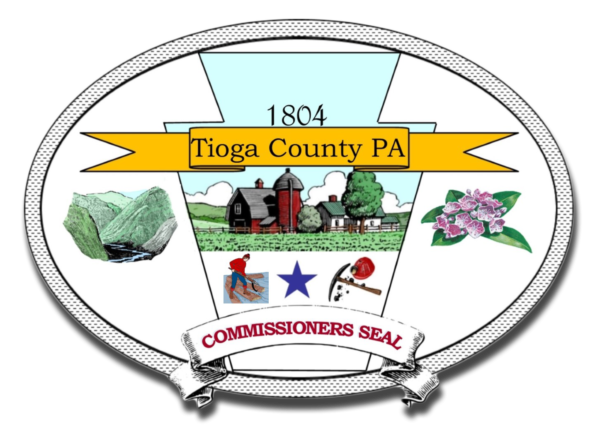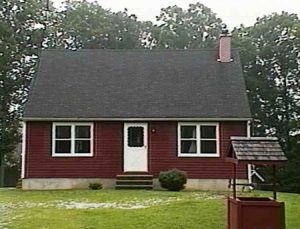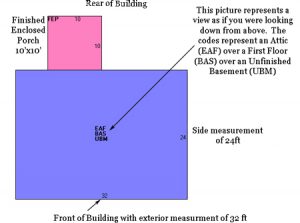
Tioga County
Countywide Reassessment
Tioga County has completed a countywide reassessment to equalize property values, effective for January 1, 2024.
You can access the online assessment database to review your assessment by clicking the link below.
What is a reassessment?
Reassessment Process Overview:
A reassessment is the process of performing all of the necessary Market Analysis and Valuation steps to determine accurate and equitable values for all properties within the County.
The equalization of the values within the County creates a fair distribution of the tax burden. The purpose of a reassessment is not to raise taxes. The purpose is to create an equitable distribution of the tax load.
1) Collect Required Physical Data
During this phase, Listers, otherwise known as data collectors, go to each property and physically inspect the exterior of each building.
They note the buildings location, size, age, and quality of construction, improvements, topography, utilities, zoning restrictions, if any, and numerous other characteristics visible from outside.
If the property recently sold, the lister will inquire about the terms of the sale. If the property is a potential income producing property (apartment, office building, etc.) the lister may inquire about rental information.
If you are unsure about a stranger approaching your property, listers will be carrying proper identification and will have their information on file at the police department and the Assessment Office.
2) Quality Control Procedures
As data is being collected, managers from both the Vision Government Solutions as well as the County often revisit a property to double check the data collection process. Property owners who are not at home at during the exterior inspection will have an opportunity to review and correct the information collected once they receive a data verification mailer.
3) Collect/Verify Specific Market Data
During this time, Data Mailers will be sent in order to gain further insight on residential properties and Income & Expense forms will be sent on commercial/industrial properties to gain further insight on lease information.
You can view examples of sample mailers by visiting the Sample Reassessment Forms section.
4) Analysis
A variety of resources are used to analyze the real estate market. While the physical data is being collected by Listers, experienced appraisers will be analyzing recent sales as well as lease information to determine which market factors influenced property values.
Once all the data is collected and reviewed for accuracy, the appraisers will begin to set values using information gathered from past market activity.
Valuation is done using one of the three widely accepted valuation methods which are the market, cost or income approach.
5) Field/Office Review and Value Correlation
Field/Office Review is the method of checking and re-checking both the values that have been determined and the data that has been collected.
During this review, properties are viewed by experienced appraisers who double check uniformity and accuracy of information.
6) Informal Hearings
Once the Field Review is completed, a Notice of New Values will be mailed to each property owner in Spring 2023.
At this time, anyone with questions concerning their value, the reassessment process or about the data collected on their property has an opportunity to meet with someone to discuss their property value.
The steps outlined here (Is my Assessment Correct?) will help you to evaluate your situation and help you to decide if you even need to schedule a hearing.
If you decide that you do need one, make sure to review the information in the Preparing for a Hearing section.
7) Project Complete
During this phase, Vision Government Solutions has made all final changes resulting from the steps outlined above. In order for the project to be complete, the County must formally accept all values.
Final Value notices will be mailed on or before July 1, 2023. Property owners will then have 40 days to file a formal appeal with the Board of Assessment Revision. Following the conclusion of formal appeals, values will be certified by November 15, 2023, with new values going into effect for the 2024 tax year.
The purpose of a Reassessment is not to raise taxes. The purpose is to create an equitable distribution of the tax load.
Why are we performing a reassessment now?
How far off the mark have current assessments for properties in Tioga County strayed from current market value?
CLR
Common Level Ratio
Since 2002, Tioga County’s Common Level Ratio (CLR), which is a ratio that measures how a county’s Base Year assessments compare with current real estate market valuations or sales, has declined from 94.8% in 2002, to 60.1% in 2020.
The State Tax Equalization Board publishes the CLR annually for each county in Pennsylvania, and the preliminary figures for Tioga County for 2021 show a proposed decrease from 60.1% to 58.3%.
Currently, the median assessment to sale ratio for all property sales is 60.1%, with some assessment to sale ratios falling above and below the median ratio.
As an example, if a property in Tioga County sells for $125,000 in 2021, and the 2001 Base Year assessment is $75,000, the assessment to sales ratio would only be 60%.
%
CLR after 2001 Reassessment
%
Current CLR
%
Projected CLR for 2021
COD
Coefficient of Dispersion
Another statistic that is used to evaluate the overall uniformity of assessments is the Coefficient of Dispersion (COD). The COD in the simplest of terms measures the overall accuracy of the property assessments based on the sale prices.
The COD measures the average percentage deviation of the assessment to sales ratio of each property sale to the overall median ratio. This ratio is basically a measure of the spread, or how wide is the range of the individual assessment to sale price ratios from the overall median ratio.
Based on a recent review of 997 residential sales that occurred from 1/1/2017 through 12/31/2020, the Tioga County Assessment Office concluded that the COD of these residential sales was 32.96. Based on the IAAO Ratio Study Standards, Tioga County currently falls outside of the generally accepted industry standards.
In general, acceptable COD’s are 20 or less, with Residential Properties at 15 or less, and newer homogeneous areas 10 or less. While the State Tax Equalization Board does not certify this statistic, based on their preliminary calculations for 2021, they calculated an overall COD for Tioga County of 35.15 based on just the 2020 sales.
This figure was in line with the numbers calculated by the Assessment Office. To illustrate this concept and understand what this statistic represents, consider the images below. Looking at the target on the left, if the center of the target represents the overall level of assessment, or percentage of assessed value to market value, a lower COD would indicate that there is less dispersion in the assessments from the recorded sale prices, and that the assessments and taxes are more accurate and uniform. A higher COD indicates more dispersion in the assessments from recorded sale prices, and that the assessments and taxes are less accurate and uniform, this can be seen on the target on the right.
What does all of this mean for our property taxes in 2024?
Reassessments are required under the Consolidated County Assessment Law 53 Pa C.S. § 8823 to be revenue neutral.
This means that the total taxes levied by a taxing district cannot automatically increase the year after a reassessment, and the tax rates are required to be adjusted so that the total taxes levied do not exceed the total taxes levied in the preceding tax year.
It is also important to note that just because an individual property assessment increases after a reassessment, does not automatically mean that the taxes will increase as well.
Because of the required millage equalization process, the change in an individual property’s taxes will ultimately be determined by the property’s change in value relative to the overall change in value countywide.
Historically, based on data that’s been published on other countywide reassessments, 1/3rd of the property owners will see a decrease in their taxes, 1/3rd will stay about the same, and 1/3rd will see an increase.
When the CLR and COD increase in accuracy after a reASSESSMENT, the County's property tax rate (millage rate) must go down so the overall amount of property taxes collected is not raised.
%
Will see a decrease in their taxes
%
Will see their taxes stay about the same
%
Will see an increase in their taxes
Project Timeline & Updates
Tioga County Commissioners Approve Issuance of RFP for Countywide REAssessment
Apr 2021 – At the Board of Commissioners meeting on April 13, 2021, the Tioga County Commissioners approved moving forward with issuing a Request for Proposal to conduct a county-wide Reassessment. Read Press Release.
Vision Government Solutions Selected to Conduct Countywide ReASSESSMENT
Jul 2021 – Tioga County Board of Commissioners Vote on Moving Forward with Reassessment to be Implemented for the 2024 Tax Year. Read Press Release.
Data Collection & Street Level Imagery
Late Sep 2021 – Vision Government Solutions staff will conduct data collection through exterior inspections and the use of street level imagery via Desktop Review.
Data Mailer
Feb 2022 – Oct 2022 – Property owners will recieve a data mailer to verify the information collected during the Data Collection phase of the reassessment.
Collection of New Construction
Mar 2022 – Feb 2023
Assessor's Preliminary Value Review
Apr 2023
Updated Values are Mailed to Tioga County Property Owners
Apr 2023
Preliminary Assessment Roll and File Submitted to Tioga County
Jun 2023
Final Value Change Notices Sent to Property Owners from Tioga County
Jul 2023
Formal Defense of Values
Jul 2023 – Nov 2023
FAQ
Frequently Asked Questions
Who is Vision?
A: Vision Government Solutions is a company which specializes in services and software designed to assist Municipalities and other jurisdictions with assessing, billing and support of zoning and building department functions. We are typically hired by municipalities and jurisdictions to help them fulfill the State requirement to reassess all real property so that the assessments reflect current market value as of a certain date. Our work is largely regulated by State law which dictates when and how we reassess properties. We have been providing appraisal services and Computer Assisted Mass Appraisal Software (CAMA) to Assessing departments located throughout the United States since 1975. During this time, we have successfully completed over one thousand revaluation projects throughout New England. We bring a significant amount of professional expertise to a project. Our large appraisal staff is comprised of State certified professionals that have significant industry experience. Our Senior Appraisal personnel average over 20 years of Municipal Appraisal experience.
Despite the fact we are a Massachusetts company our employees live and work throughout New England. Because our employees are geographically dispersed, we can assign them to projects in their home State thus allowing them to apply their local knowledge to their professional experience.
As a company, we fully understand that a revaluation can have a very real economic impact within a County once the results are released. Revaluations have a long history of creating intense conjecture and debate with respect to fairness and accuracy. It is with this understanding that we take great pains to ensure that every one of our appraisals accurately reflects current market value as defined by each State. We also work closely with our clients after values are released to make sure the process is understood and accepted. Counties and ultimately taxpayers are heavily dependent on the property tax to pay for important services such as police, fire and public schools. It is through the delivery of professional, properly executed cyclical property revaluations that we can assist our clients with the important task of ensuring that these vital property tax levies are fairly and equitably distributed.
Is my assessment correct?
A: The following 3 questions can help you decide if your assessment is correct.
Please note: If you are concerned that your taxes are going to double because your property value has doubled, that is usually not the case.
Since everyone else’s property value is also rising, the tax rate usually drops somewhat proportionally to the amount of total increase to the County’s total value.
1) Can I sell my property for that amount?
The first thing that you should do is ask yourself if you could sell the property for approximately that amount.
2) Does the Assessment Office have the correct information on my property?
You can review the information that the Assessment Office has collected on your property to make sure the data is accurate. Tioga County hosts this information online in our Online Database.
While reviewing your property, you should make sure that all measurements on the sketch are accurate. Please note that all measurements are taken from the exterior. You should also check the land size and interior data to ensure accuracy.


3) How much have similar properties in my neighborhood been assessed for?
You can look up the assessed value of similar parcels that are located near your property in Tioga County’s Online Database by using the Street Listing option at the top of the page.
Please be aware that what may appear to be a similar parcel may in fact be very different from your property.
What approach will be used to determine value?
A: The Tioga reassessment team will employ a market adjusted cost approach which it has successfully utilized on over 500 valuation projects. It is a system that is very effective for estimating market value.
Land valuation will be accomplished through an analysis of vacant sales, as well as a land residual analysis, which is accomplished by deducting improvement values and extracting land values from improved sales. This analysis results in a base land curve. In each community, neighborhoods will be established that represent similar value patterns and neighborhood factors will be established. Each neighborhood, street by street, will also be rated for desirability which provides a second factor that may be applied to the base square foot or acreage schedule to account for differences in location. In addition, factors will be applied to account for negative or positive influences on value such as topography, view, irregular lot shape, waterfront and other factors.
Overall property values, including improvement value, will be verified by the sales ratio analysis, segregated by the pertinent value related factors of each property. This analysis will be stratified within various categories including style of property, segmented by size and age, by lot size and location factors. This analysis enables the Project Management team to fine-tune the final tables for each property to create a mirror image of market sales activity within the County.
For commercial/industrial properties, all three approaches to value will be employed. For commercial/industrial properties that are basically non-income-producing, the secondary approach will be the market approach, utilizing the square foot values derived from the sales analysis for the particular use type of the property. Square foot values will be segregated by type, including industrial, warehouse, retail, etc. and will provide reasonable ranges for per square foot sale prices of building areas. Land value, once determined, will be added to building value for an estimate of total value. For all income producing commercial property, the income approach, utilizing a direct capitalization approach, will be employed.
The replacement cost approach to value will be employed for both residential and commercial and industrial properties as follows:
Information derived from our cost analysis will provide the basis for determining the cost pricing schedules used in the valuation of residential and commercial/industrial properties.
Subsequent to the determination of replacement cost pricing schedules and the establishment of land values, the team will analyze the sales of improved properties in order to derive an estimate of physical and functional depreciation and economic obsolescence.
Physical and functional depreciation and economic obsolescence will be computed to be the difference between the selling price of the total property and the sum of the estimated replacement cost new of the improvement plus the estimated land value.
Provided that a sufficient number of sales are available, guidelines in the form of tables based upon the condition, desirability and usefulness of a building relative to its actual age will be developed. After approval by the Assessor, these tables will be used to estimate the depreciation of comparable subject properties.
All of these tables are then applied to each parcel in the County. Each property is then reviewed by an appraiser. During this review, the appraiser rechecks the physical data and then ensures that the value is consistent with the sales activity within the immediate area. This value then becomes the final proposed value and once accepted by the County becomes the final assessed value.
Is the valuation model that Vision uses a proprietary model?
A: Absolutely not. Below we have listed sample models used for valuing residential buildings and residential building lots. Please be aware that our models are built to represent market conditions within a County and therefore they can vary between different Counties. Nevertheless, a typical building and land model are depicted below. All beginning costs are arrived at by performing an in depth study of the local market which is a process that includes one or more of the following steps- a complete review of recent County sales transactions, consultations with local builders, consultations with local realtors, an examination of transactions where new properties were built and sold as well as the use of nationally recognized building cost manuals.
Residential Building Valuation Model
Beginning Square foot price
+/- Physical characteristics (bedrooms, bathrooms, quality of construction, flooring, fireplace etc…)
= Adjusted cost per square foot
Adjusted cost per square foot x building square footage
– Building depreciation
= Building value
Land Valuation Model
Land units
x Unit price
x Land condition adjustment
x Location adjustment
= Land value
What is a reassessment?
A: A reassessment is the process of performing all of the necessary Market Analysis and Valuation steps to determine accurate and equitable values for all properties within a municipality. The purpose of a reassessment is not to raise taxes. It is to create an equitable distribution of the tax load.
What happens during a reassessment?
A: A physical inspection of the exterior of each property is conducted. While data collection is being conducted, appraisers are studying the recent market sales in order to gain a full understanding of the real estate market in your County. This study of recent property sales allows the appraisers to establish valuation models used to estimate the value of properties that have not sold using comparisons with recent sales. The valuation models are applied to all non-sale properties in order to approximate the market value of each property.
How will I know if my assessment is equitable?
A: Refer to our Is My Assessment Correct? section.
Why did my land value change differently than my building value?
A: Since the last reassessment, real estate values have changed significantly. Over the same period, building construction costs have increased at a slower rate than property values have appreciated. Since building costs have not increased as much as total values, the bulk of the total increase, if any, is attributable to land. This makes perfect economic sense, as it is land that is limited supply.
What is an informal hearing?
A: Towards the end of the reassessment, every property owner receives a notice of their proposed valuation. If they have a question or concern about the proposed valuation, they are asked to call the Assessor or their contractor to set a date and time for an informal hearing. This appointment is meant to allow a brief discussion about the valuation process, review the specifics of the property in question and to answer general questions the owner may have. Most hearings last about 10-15 minutes. Homeowners are asked to come prepared with their questions and have compared their property to other comparable ones in their neighborhood. They are also encouraged to provide the hearing officer with copies of any documentation they may have regarding specific issues with their proposed assessments. See Preparing for a Hearing for more information on appropriate documentation.
It is important to remember that an informal hearing is not a forum to discuss taxes or town politics nor is it an in-depth class on appraisal practices and theory. It is strictly meant to answer general questions on the proposed property assessments. The hearing officer will takes notes during your meeting to document the information you have discussed. They will later determine if further review of your property assessment is necessary based on these notes. The proposed values are not final until all hearings and any data or value changes resulting from the hearings are completed.
How do I prepare for an informal hearing?
A: It is up to the taxpayer to make the case that the assessment is incorrect. Therefore, it is highly recommended that you come to a hearing fully prepared to state your case.
After you have completed all of the steps outlined in Is My Assessment Correct?, you may decide that you want to schedule a hearing. You may have uncovered a data error, found some comparable sales that support a lower assessment on your property or you may want to make someone aware of an irregularity that affects the value of your property. When attending the hearing, you should come prepared to prove your case. It is up to you to convince the hearing officer why the value is incorrect if you are to receive a change of value. If you supplied information in the past that lowered your value, bring it along again. Please be aware that the information may already be on your record and may already be reflected in your value.
If you are challenging the value on your property, please bring in recent, comparable sale properties that are located close to your property or are in an area that is similar to your property. A recent appraisal usually contains this information and can be helpful to proving your case provided that the appraisal actually comes in lower than your proposed assessment. Simply saying that the value is too high or offering to sell it to the hearing officer for the assessment amount will not be viewed as good reasons to lower your value.
If you have an issue pertaining to the use of your property, please bring in supporting evidence such as a deed showing a usage restriction or a plot plan which outlines any topographical irregularities.
If you want to make us aware of other issues, please bring in pictures, past documentation or anything else that will help you to prove your case.
For all documentation, please bring copies that you can leave with the hearing officer as there may not be access to a copier and original documents cannot be guaranteed a safe return to you.
How will I know if a change was made to my assessment after my hearing?
A: At the conclusion of the hearings for your County, appraisal staff will review the notes from your hearing and any information you have provided on your property. They will make changes to the data and/or value of the property if appropriate. After this final review process is complete for all properties, another notice is sent to you. The new value on this notice will reflect the changes made based on your hearing. This value will now be considered your new assessment and will be reflected in the Assessors records.
If I disagree with my assessment after an informal hearing, what are my options?
Contact your local Assessors office for this information.
Will a reassessment increase taxes?
A: A revaluation may result in an increase or decrease of individual taxes depending on how a property value increased or decreased relative to the average change in the County’s assessments. It does not mean that all property taxes will increase or decrease. Remember assessments are only the base that is used to determine the tax burden. The tax burden is the amount that the municipality must raise to operate the local government and support the many services each of us has come to expect, such as schools, police, etc. As an example, if the same amount of money is to be raised after the revaluation as the previous year and each assessment doubles, the tax rate would merely be cut in half.
What is the “market” and who determines my property value?
A: The value of your property is based on an analysis of the entire market for a specified period of time before the completion of the revaluation project. The market can generally be defined as, you, the person who sold the property to you, and the person willing to buy it from you. It is the appraiser’s job to research and analyze the values in any particular area or neighborhood. In effect, they do what you would do to determine the selling price when putting your property up for sale. However, the appraiser has specific guidelines to follow during their research. Some factors that are examined for each property are: location, size, quality of construction, age of improvements, topography, utilities, zoning restrictions, if any, etc.
Will all property values change?
A: Most likely, yes. However, not all property values will change at the same rate. Market value may have increased more for some neighborhoods and property types than for others. Some neighborhoods and property types may have decreased in value and others may have remained the same. One purpose of a revaluation is to make sure that the assessed values reflect the changes that have occurred in the real estate market.
What is market value?
A: Market value has been defined by the courts as, “The price in a competitive market a purchaser, willing but not obligated to buy, would pay an owner, willing but not obligated to sell, taking into consideration all the legal uses to which the property can be adapted and might be reasonably applied.” (See Buhl Found. v. Board of Prop. Assessment, 180 A.2d 900 (Pa. 1962).
The Market value represents the typical selling price for the property, unaffected by special or creative financing or sales concessions granted by anyone associated with a sale.
What sales did you compare to my home to arrive at my value?
A: This question highlights one of the clear differences between the revaluation appraisal process and the more well-known fee appraisal. Most homeowners have had a fee appraisal of their property before and are familiar with the process involved and the resulting report. Many assume that the revaluation company uses the same process. Although the appraisal concepts are the same and the results similar, the process is different.
In a revaluation, the value of your property is based on an analysis of the sales within your market area for a specified period of time. (usually a one or two year period). This study of recent property sales allows the appraisers to establish valuation parameters (construction rates, land rates, market adjustments, etc). Once these valuation parameters are applied to the properties that sold, the result is an appraised value that is very close to the sales price.
The revaluation appraisers test the newly developed parameters then apply these same valuation parameters to all of the “non-sale” properties in the County. In doing so, they are approximating the market value of each property using the information derived from all of the sales. Therefore, no particular sale or group of sales was used to determine the value your property. This is because ALL of the recent sales were included in the analysis that set the parameters used in the revaluation of your town.
What if there hasn't been a recent arms - length sale of my property?
A: The next best evidence is the arms length sales of reasonably comparable properties. These are properties similar to yours in location, age, style, condition, and other features that affect market value, such as the number of bedrooms and bathrooms and size of garage.
What if there are no reasonably comparable sales?
A: We will then consider all other factors that may affect the market value of your property. The cost to replace your building(s), less any depreciation, plus the value of the land could be used to estimate market value. For income producing properties, the income and expenses could be considered.
I have recently built my home. Will the actual construction costs be considered?
A: Your construction cost is a historical figure that may or may not reflect the current market value of your property. It is only one element that will be considered.
What will happen to my assessment if I improve my property?
A: Generally speaking, improvements that increase the market value of a property will increase the assessment. The following examples are typical items that may increase the assessed value of your property. – adding living or rentable area – substantial modernization of kitchen or baths – extensive remodeling – adding features such as A/C, finished basement rooms, garages, pools, etc.
Will my assessment go up if I repair my property?
A: Normal maintenance will help retain the market value of your property, but generally will not affect your assessment.
How can my assessment change when I haven't done anything to my property?
A: General economic conditions such as interest rates, inflation rates, and changes in the tax laws will influence the value of real estate. As property values change in the marketplace (sales), those changes will eventually be reflected on the assessment roll.
Do all assessments change at the same rate?
A: There are differences between individual properties and between neighborhoods. In one area, the sales may indicate a substantial increase in value in a given year. In another neighborhood, there may be a lesser change in property values.
Different types of properties within the same neighborhood may also show different value changes. For example, one – story houses may be more in demand than two – story houses or vice versa. Older homes in the same area may be rising in value more slowly than newer homes.
Among the numerous factors to be considered that will cause values to differ are location, condition, size, quality, number of baths, basement finish, garages, and many others.
Will the person who inspects my property be able to tell me my new assessment?
A: No. If an inspection is necessary on your property, we have to analyze all of the information we gathered before placing a value on your property. We will then further review this information to ensure that your assessment corresponds fairly to the assessments of other properties.
Nobody inspected the inside of my home, so how could you reassess it?
A: The Assessors Office maintains a complete record for each property. Information is kept current through permit inspections, sales inspections, periodic re-inspections and exterior reviews. The records are available for your review. This information is used to develop the new assessments.
I've heard you develop values by computer. Is this correct?
A: Just as in many other fields, computers are useful in the assessment process. Assessors are trained to look for relationships between property characteristics and market value. By coding these characteristics and studying sale prices, assessors can estimate value by developing formulas and models. Computers are much faster and are capable of advanced analysis in this area. Despite these capabilities, common sense and assessor judgment are always required to verify assessments. Assessors most familiar with the neighborhoods and properties review all assessments.
Contact Us
Have another question? Get in touch!
Tioga County Assessment Office
118 Main St, Wellsboro, PA 16901
Joshua Zeyn – Chief Assessor
Phone: (570) 724-9117
Fax: (570) 723-8118
Vision Government Solutions
1 Cabot Road #100, Hudson, MA 01749
Phone: (800) 628-1013 ext. 1





